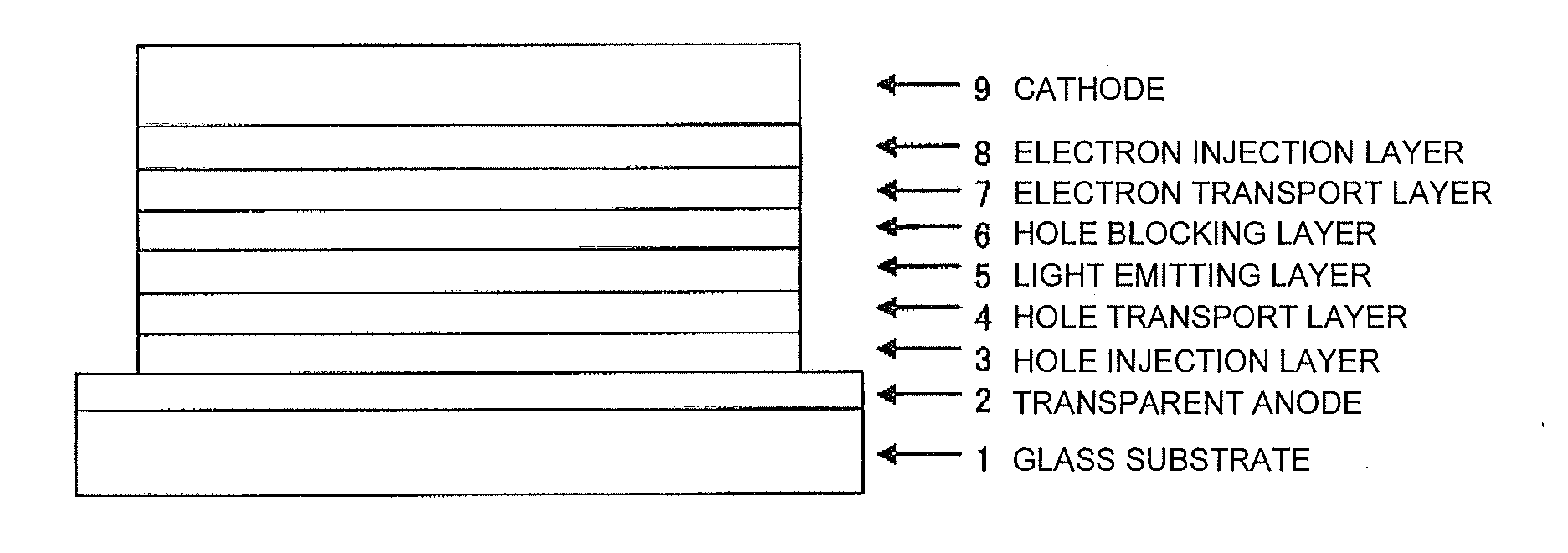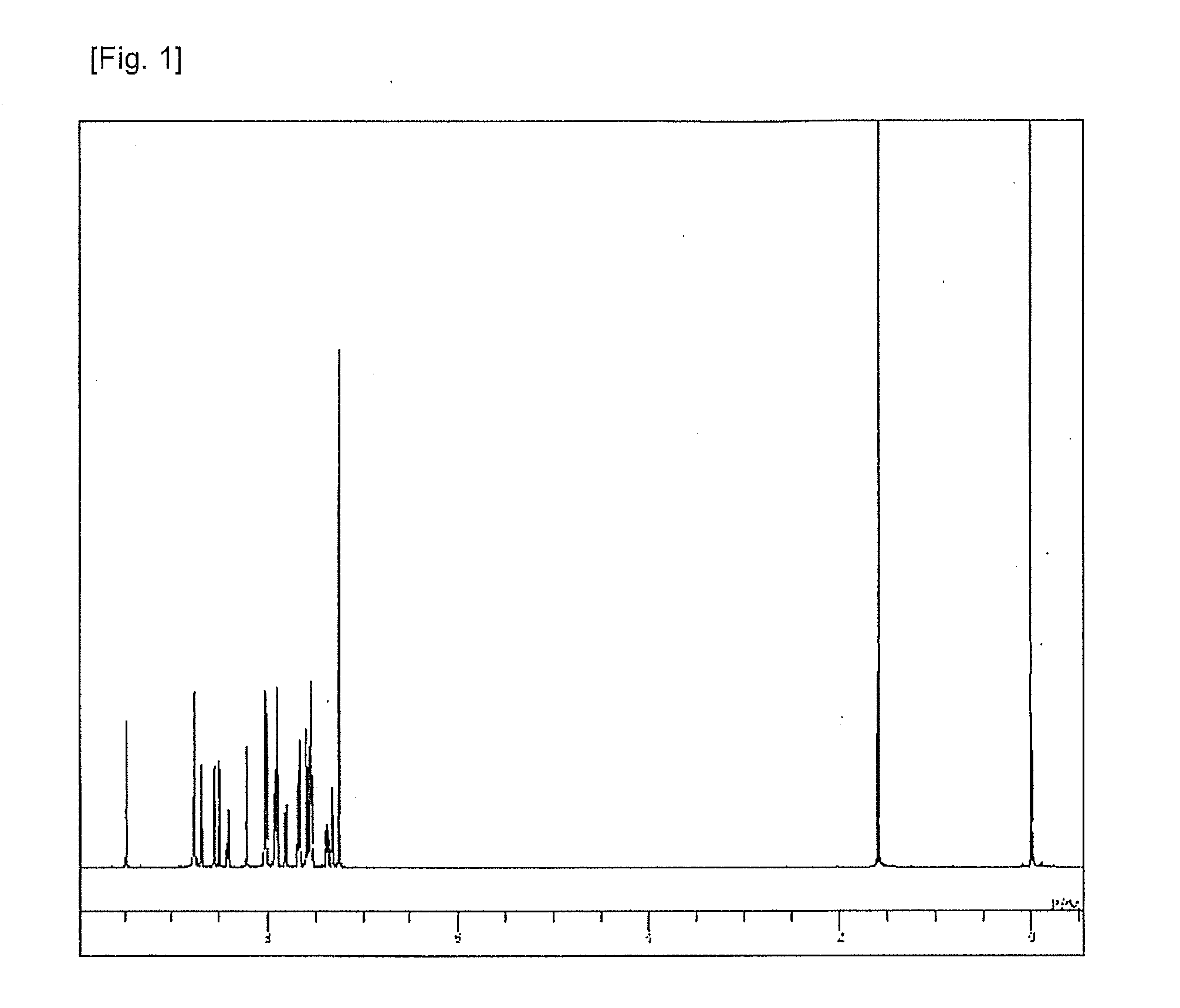Compound having substituted bipyridyl group and pyridoinodole ring structure, and organic electroluminescent device
- Summary
- Abstract
- Description
- Claims
- Application Information
AI Technical Summary
Benefits of technology
Problems solved by technology
Method used
Image
Examples
example 1
Synthesis of 8-[4-{6-(naphthalen-2-yl)-[2,2′]bipyridine-4-yl}-phenyl]-5-phenyl-5H-pyrido[4,3-b]indole (Compound 2)
[0078]2′-Acetonaphthone (16.1 g), iodine (24.2 g), and pyridine (72 ml) were added into a reaction vessel, heated, and stirred at 100° C. for 3 hours. The mixture was cooled to a room temperature, and after water (170 ml) was added, purification by recrystallization was performed. The product was dried under reduced pressure at 70° C. for 12 hours to obtain a brown powder of 1-{2-(naphthalen-2-yl)-2-oxoethyl}pyridinium iodide (31.3 g; yield 88%).
[0079]4-Bromobenzaldehyde (15.4 g), 2-acetylpyridine (10.1 g) and methanol (140 ml) were added beforehand into a reaction vessel and cooled to −5° C. while being stirred, and then a 3% (wt / wt) NaOH methanol solution (140 ml) was dropped and further stirred for 2 days to prepare a solution. The obtained 1-{2-(naphthalen-2-yl)-2-oxoethyl}pyridinium iodide (31.3 g), ammonium acetate (80.3 g) and methanol (180 ml) were added to the p...
example 2
Synthesis of 8-[4-{6-(biphenyl-4-yl)-[2,2′]bipyridinyl-4-yl}-phenyl]-5-phenyl-5H-pyrido[4,3-b]indole (Compound 8)
[0083]The same process as Example 1 was applied to synthesize 6-(biphenyl-4-yl)-4-(4-bromophenyl)-[2,2′]bipyridine from 4-acetylbiphenyl. The obtained 6-(biphenyl-4-yl)-4-(4-bromophenyl)-[2,2′]bipyridine (3.7 g), 8-bromo-5-phenyl-5H-pyrido[4,3-b]indole (3.3 g), tetrakis(triphenylphosphine)palladium (0) (0.3 g), a 2M potassium carbonate solution (12 ml), toluene (30 ml), and ethanol (7 ml) were added into a reaction vessel substituted with nitrogen, and heated under reflux for 3 hours while being stirred. The mixture was cooled to a room temperature, and a deposited crude product was collected by filtration. The crude product was purified by column chromatography (carrier: NH silica gel, and eluent: toluene) to obtain a white powder of 8-[4-{6-(biphenyl-4-yl)-[2,2′]bipyridinyl-4-yl}-phenyl]-5-phenyl-5H-pyrido[4,3-b]indole (Compound 8) (1.7 g; yield 34%).
[0084]The structure...
example 3
[0086]The melting point and glass transition point of the compounds of the present invention were determined using a high-sensitive differential scanning calorimeter (DSC 3100S produced by Bruker AXS).
GlassMeltingtransitionpointpointCompound of Example 1 of the255° C.122° C.present inventionCompound of Example 2 of the246° C.128° C.present invention
[0087]The compounds of the present invention have glass transition points of 100° C. or higher. This demonstrates that the compounds of the present invention have a stable thin-film state.
PUM
 Login to View More
Login to View More Abstract
Description
Claims
Application Information
 Login to View More
Login to View More - R&D
- Intellectual Property
- Life Sciences
- Materials
- Tech Scout
- Unparalleled Data Quality
- Higher Quality Content
- 60% Fewer Hallucinations
Browse by: Latest US Patents, China's latest patents, Technical Efficacy Thesaurus, Application Domain, Technology Topic, Popular Technical Reports.
© 2025 PatSnap. All rights reserved.Legal|Privacy policy|Modern Slavery Act Transparency Statement|Sitemap|About US| Contact US: help@patsnap.com



